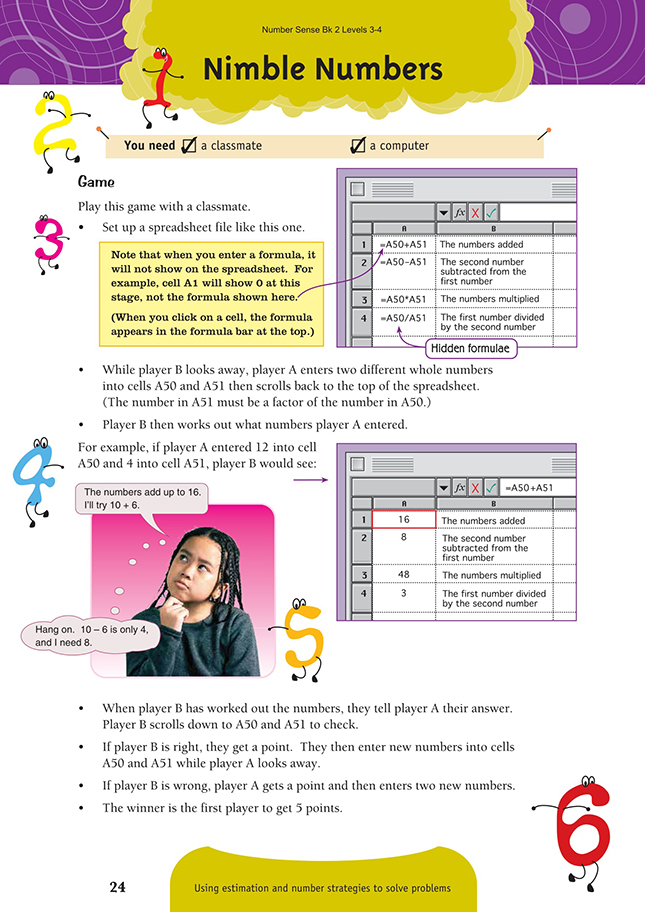This is a level 4 number activity from the Figure It Out series. It relates to Stage 7 of the Number Framework.
A PDF of the student activity is included.
Click on the image to enlarge it. Click again to close. Download PDF (279 KB)
use estimation and number strategies to solve problems
Number Framework Links
This game is suitable for students using advanced multiplicative (stage 7) strategies. It can easily be adapted for those using advanced additive strategies (stage 6).
FIO, Levels 3-4, Number Sense and Algebraic Thinking, Book Two, Nimble Numbers, page 24
A classmate
A computer
In this game, students use estimation and number strategies to work out hidden whole numbers. The game will support the development of strategies based on multiplication and division and gives students excellent practice with basic facts and factors. It can also provide practice with estimation.
You will need to check that the students know how to type formulae into a cell. They also need to know that the * (asterisk) is the spreadsheet symbol for multiplication and that the / (slash) is the spreadsheet symbol for division.
You can easily adjust this game to suit particular groups of students. Here are some suggestions:
• For students at the advanced additive stage, limit the size of the numbers they can use to 20. This will still allow over two dozen pairs of numbers that meet the criteria without using 1 as a factor: (20, 10), (20, 5), (20, 4), (20, 2), (18, 9), (18, 6), (18, 3), (18, 2), (16, 8), and so on. These numbers will give the students a lot of practice with basic facts.
• For students at the advanced additive stage who are struggling to make the next stage, change the fourth formula to read =A50/10. This will mean that they can always find the first number simply by multiplying the result they see in the fourth cell by 10. The second number can then be easily found using any of the other three clues.
• For students at the advanced multiplicative stage, increase the size of the numbers they can use to 100. This means that, to be a factor, the maximum size of the second number can be no more than 50. Some of the many possible pairs are: (100, 50), (96, 16), (55, 11), (84, 12) … This will increase the pool of potential pairs of numbers and will require the students to make use of a wider range of mental strategies as they add, subtract, multiply, and divide.
• To greatly increase the pool of possible number pairs, delete the fourth formula (=A50/A51). The three clues are still sufficient for the numbers to be found. Possible number pairs now include: (23, 17), (85, 9), (14, 13), (48, 15) … The rules state that the first number is always the bigger number, so students won’t have to meet negative numbers.
• To make things more difficult, delete the second or third formula. This will leave just two clues, which is still enough for a solution to be found but will mean that the students have to make very good use of those two clues. If you decide to do this, try limiting the numbers that the students can use to ones that are 20 or less until they have gained some confidence.
• Widen the range of numbers that can be used to include numbers with one or two decimal places. The students will need to use estimation more.
• Vary the scoring rules or the total number of points needed to win a game. Able students could be given a higher score to aim for in order to win, or as soon as one person has a lead of 3 points, they are declared the winner.
Answers to Activity
A game using estimation and number strategies to solve problems
